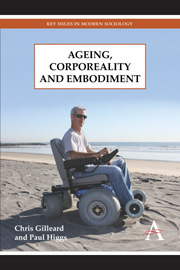Book contents
- Frontmatter
- Contents
- Introduction
- Chapter 1 Identity, Embodiment and the Somatic Turn in the Social Sciences
- Chapter 2 Corporeality, Embodiment and the ‘New Ageing’
- Chapter 3 Gender, Ageing and Embodiment
- Chapter 4 Age and the Racialised Body
- Chapter 5 Disability, Ageing and Identity
- Chapter 6 Sexuality, Ageing and Identity
- Chapter 7 Sex and Ageing
- Chapter 8 Cosmetics, Clothing and Fashionable Ageing
- Chapter 9 Fitness, Exercise and the Ageing Body
- Chapter 10 Ageing and Aspirational Medicine
- Conclusions: Ageing, Forever Embodied
- References
- Index
- ADVANCE PRAISE
Chapter 7 - Sex and Ageing
Published online by Cambridge University Press: 05 July 2013
- Frontmatter
- Contents
- Introduction
- Chapter 1 Identity, Embodiment and the Somatic Turn in the Social Sciences
- Chapter 2 Corporeality, Embodiment and the ‘New Ageing’
- Chapter 3 Gender, Ageing and Embodiment
- Chapter 4 Age and the Racialised Body
- Chapter 5 Disability, Ageing and Identity
- Chapter 6 Sexuality, Ageing and Identity
- Chapter 7 Sex and Ageing
- Chapter 8 Cosmetics, Clothing and Fashionable Ageing
- Chapter 9 Fitness, Exercise and the Ageing Body
- Chapter 10 Ageing and Aspirational Medicine
- Conclusions: Ageing, Forever Embodied
- References
- Index
- ADVANCE PRAISE
Summary
In the last chapter we explored sexuality as an embodied identity that acquired new social and political purchase in the wake of the 1960s' sexual revolution. The ageing of the post-Stonewall generation - and the impact of the AIDS/HIV epidemic - influenced the subsequent gendered construction of age and ageing within the gay, lesbian and bisexual communities. One consequence has been queering/questioning the corporeal essentialism of ‘heteronormative’ ageing; the other a greater reflexivity expressed about issues of ‘age’ and ‘sex’ that has become evident inside and outside the gay and lesbian communities. Re-interpreting gender and sexuality as forms of embodied identity, has led to sex becoming an ‘embodied practice’, fashioning the identities both of gender and of sexual orientation at the same time as influencing the ideals of a healthy lifestyle and of ageing well (Elders 2010).
Sexual performance and the embodied practices related to it have been central to the ‘identity’ conferring nexus of sexuality. While gay and lesbian sub-cultures have not just been about sex and sexual partnering, without sex, sexual identities are separated from the key element of their embodiment. One of the challenges in maintaining a gay or lesbian identity throughout adult life is consequently how to continue to represent oneself and to see others represented as potential sexual partners in a more demanding way than was traditionally the case in the heterosexual life course. This has the result both of ‘queering’ age as a de-gendered, de-sexualised identity or status, while challenging the essentialised ageism evident within gay and lesbian communities.
- Type
- Chapter
- Information
- Ageing, Corporeality and Embodiment , pp. 101 - 114Publisher: Anthem PressPrint publication year: 2013

